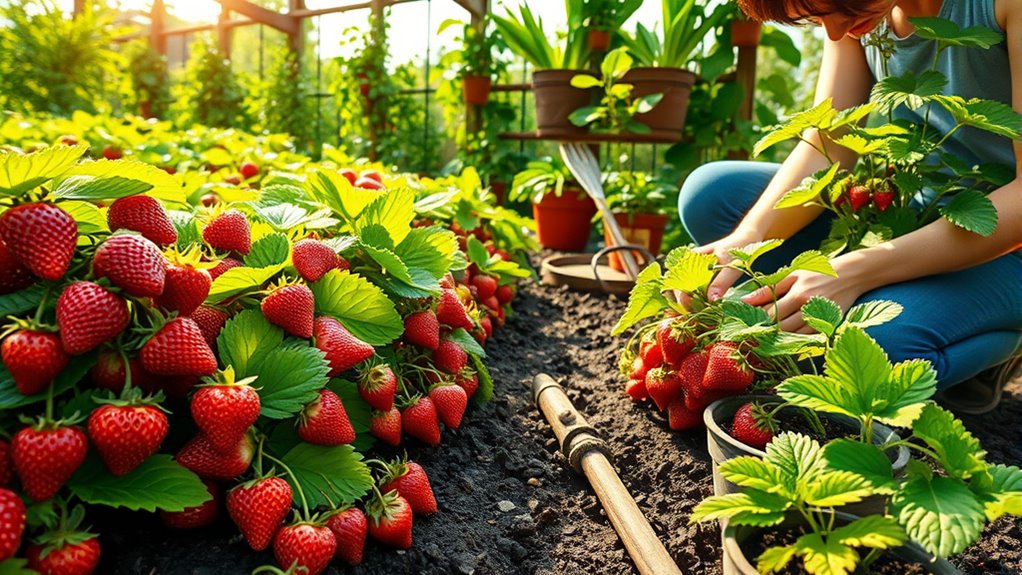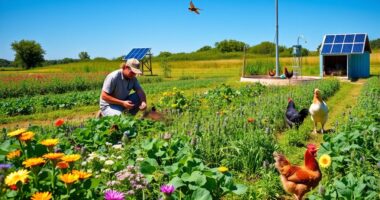When I grow strawberries, I focus on choosing high-yield varieties like the Cavendish that flourish in my climate. I use well-draining soil rich in nutrients and guarantee my plants get plenty of air circulation with supports. I water deeply, but not too much, to prevent root rot. Plus, I utilize space-saving designs like stackable planters for the best results. If you’re keen to boost your strawberry harvest, I’ve got more tips to share!
Key Takeaways
- Choose high-yielding and climate-appropriate strawberry varieties, like Cavendish, for optimal growth and fruit production.
- Utilize vertical gardening solutions and support structures to maximize limited space and enhance air circulation around plants.
- Ensure well-draining, nutrient-rich soil with a pH of 5.5 to 6.8 for robust strawberry growth and fruiting.
- Implement effective watering techniques, such as drip irrigation, to maintain soil moisture while preventing root rot.
- Monitor for pests regularly and maintain cleanliness to enhance strawberry yield and overall plant health.
10 Bareroot Cavendish Strawberry Plants for Growing Outdoors
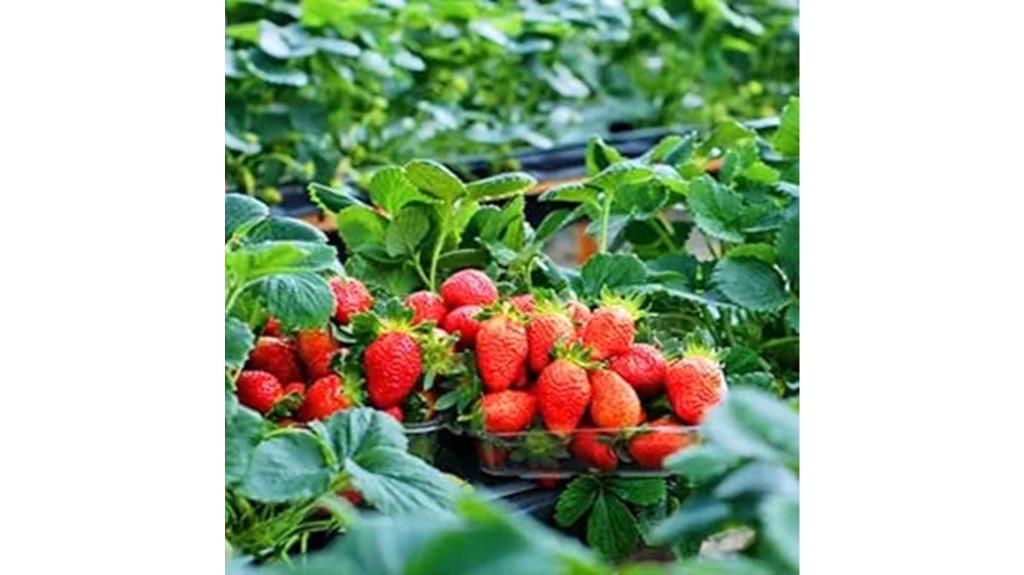
If you’re looking to grow strawberries in your outdoor space, the Bareroot Cavendish Strawberry Plants are an excellent choice. I’ve planted these 10 bareroot varieties, and they thrive wonderfully in my garden. They’re high-yielding, so I enjoy fresh strawberries throughout the season. These plants fit perfectly in small gardens or even on my balcony, giving me flexibility in planting options. Whether you use containers or hanging baskets, they adapt well. Plus, they’re hardy in zones 2-10 and easy to care for. Trust me, with a little attention, you’ll have a sweet strawberry harvest in no time!
Best For: Gardeners looking for high-yielding strawberry plants suitable for small outdoor spaces or balconies.
Pros:
- High-yielding plants provide an abundance of fresh strawberries throughout the season.
- Versatile planting options, allowing for cultivation in containers or hanging baskets.
- Hardy in zones 2-10, making them suitable for a wide range of climates.
Cons:
- Requires some attention and care to ensure optimal growth and fruit production.
- Limited to specific hardiness zones, which may not be suitable for areas outside zones 2-10.
- Being bareroot, they may need extra initial care during planting to establish properly.
Mr. Stacky 5 Tier Stackable Planter for Indoor/Outdoor Gardening
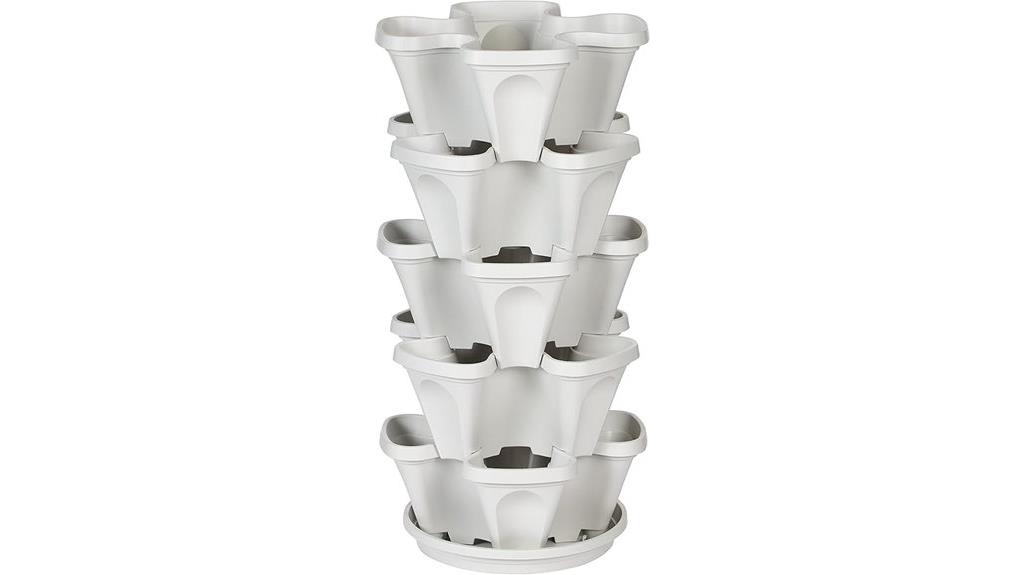
The Mr. Stacky 5 Tier Stackable Planter is a game-changer for my indoor and outdoor gardening. Its vertical design maximizes space, making it perfect for my small patio. I love how it holds up to 25 quarts of soil and features a patented flow-through design that guarantees efficient watering. Assembly is a breeze, and I can easily move it around as needed. I’ve noticed my strawberries thrive, though I recommend watering the top tier individually for the best results. Just remember to pack the soil down to support the roots. It’s a fantastic solution for anyone looking to grow fresh produce!
Best For: Urban gardeners or individuals with limited outdoor space looking to grow herbs, strawberries, and small vegetables.
Pros:
- Space-saving vertical design allows for efficient use of limited areas, perfect for patios or apartments.
- Easy assembly and mobility make it convenient to set up and relocate as needed.
- Effective water management with a patented flow-through design supports healthy plant growth.
Cons:
- Stability concerns in windy conditions may require additional measures for secure placement.
- Uneven watering can occur without careful management, particularly in the upper tiers.
- Limitations for larger plants like tomatoes and peppers, which may not thrive in the stackable design.
Mr. Stacky 5-Tier Strawberry Planter Pot, 5 Pots
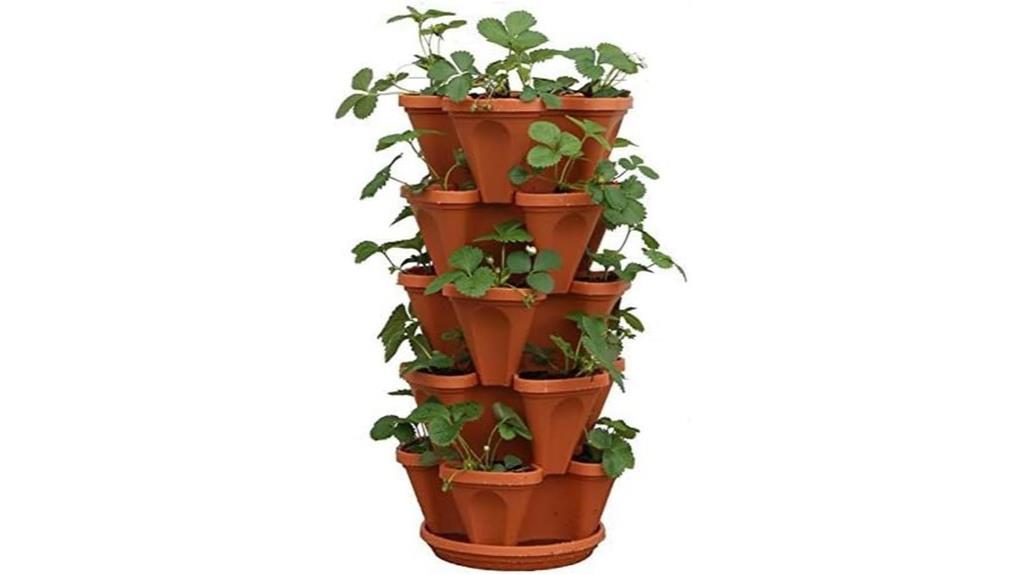
For anyone looking to maximize their gardening space, the Mr. Stacky 5-Tier Strawberry Planter Pot is a game changer. With its vertical design, I can grow strawberries, herbs, and even flowers in just 16.5 inches of space. The durable, UV-resistant plastic holds up well outdoors, while the included drip tray keeps my indoor area tidy. I love that it has a flow-through watering system, preventing overwatering. Just remember to add gravel for better drainage. With 24 quarts of capacity, I’ve seen my plants thrive beautifully. Plus, I appreciate the option to separate it into two planters when needed.
Best For: Gardeners with limited space who want to grow a variety of plants like strawberries, herbs, and flowers in a vertical planter.
Pros:
- Vertical design saves space, making it ideal for small gardens or indoor areas.
- Flow-through watering system prevents overwatering and promotes healthy plant growth.
- Versatile with the option to separate into two different planters for various gardening needs.
Cons:
- Some users reported drainage issues that may require additional adjustments like adding gravel.
- Mixed reviews on long-term durability, with concerns about the plastic becoming brittle over time.
- Larger size may create shade, necessitating careful placement for sun-loving plants.
Hanging Strawberry Grow Bag with 12 Holes (2-Pack)
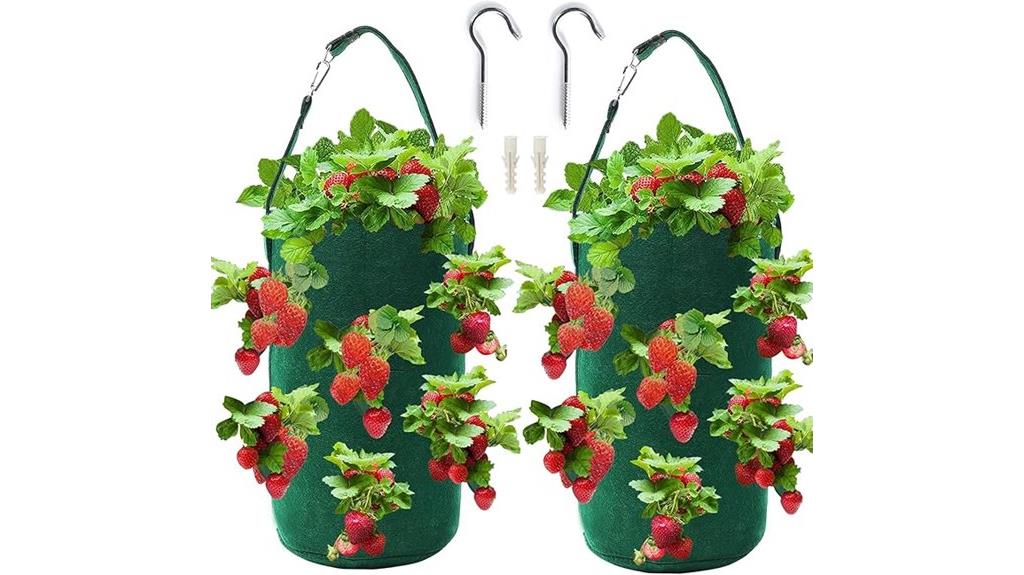
Looking to maximize your gardening space? The Hanging Strawberry Grow Bag with 12 holes is a fantastic option. Made from eco-friendly, heavy-duty fabric, it promotes excellent air circulation and drainage. I love how easy it is to fill with soil and hang using the convenient carabiner clip. While some might find inserting plants through the holes a bit tricky, the compact design is perfect for balconies and patios. Just be cautious about water retention to prevent root rot. Overall, this 2-pack grow bag is a practical solution for growing strawberries and herbs in smaller areas.
Best For: Gardeners with limited outdoor space looking to grow strawberries and herbs in a compact vertical setup.
Pros:
- Durable Material: Made from heavy-duty, eco-friendly fabric that ensures longevity and reusability.
- Excellent Drainage: Designed to promote air circulation and prevent water retention, reducing the risk of root rot.
- Easy Installation: Convenient carabiner clip allows for simple hanging on various surfaces.
Cons:
- Difficulty Planting: Some users experience challenges inserting plants through the holes.
- Size Expectations: A few customers report the grow bags are smaller than anticipated and that hangers are not included.
- Lack of Instructions: Users noted the absence of written guidelines, leading them to seek online resources for help.
Iceyyyy 5 Pack Strawberry Plant Support
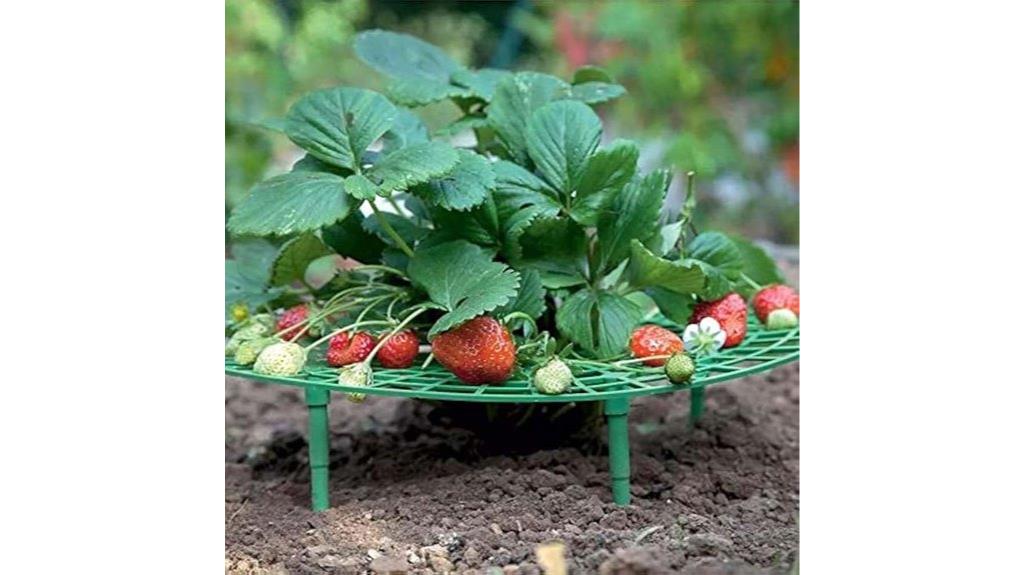
Strawberry enthusiasts will appreciate the Iceyyyy 5 Pack Strawberry Plant Support for its simple assembly and effective design. It includes two rails, four stakes, and a connecting rod, all weighing just a pound. I found it easy to fit around my plants, snap the ends together, and lock the buttons. This support not only keeps my berries clean and dry but also elevates them off the ground, improving air circulation and reducing rot risk. While some users noted durability concerns, I love the flexibility of removing it for off-season storage. Overall, it’s a solid investment for any strawberry gardener!
Best For: Strawberry gardeners looking for an easy-to-use support system to keep their plants healthy and off the ground.
Pros:
- Easy assembly with snap-together components for quick setup.
- Enhances air circulation and keeps berries clean and dry, reducing the risk of rot.
- Flexible design allows for off-season storage without needing to repurchase annually.
Cons:
- Some users reported durability issues, with parts potentially breaking during assembly.
- May not accommodate larger plants effectively; varying sizes in packs could be beneficial.
- Limited customer support for warranty inquiries, as information is only available upon request.
Upside Down Tomato Planter – 3 Gallon Hanging Strawberry Planter (Set of 3)
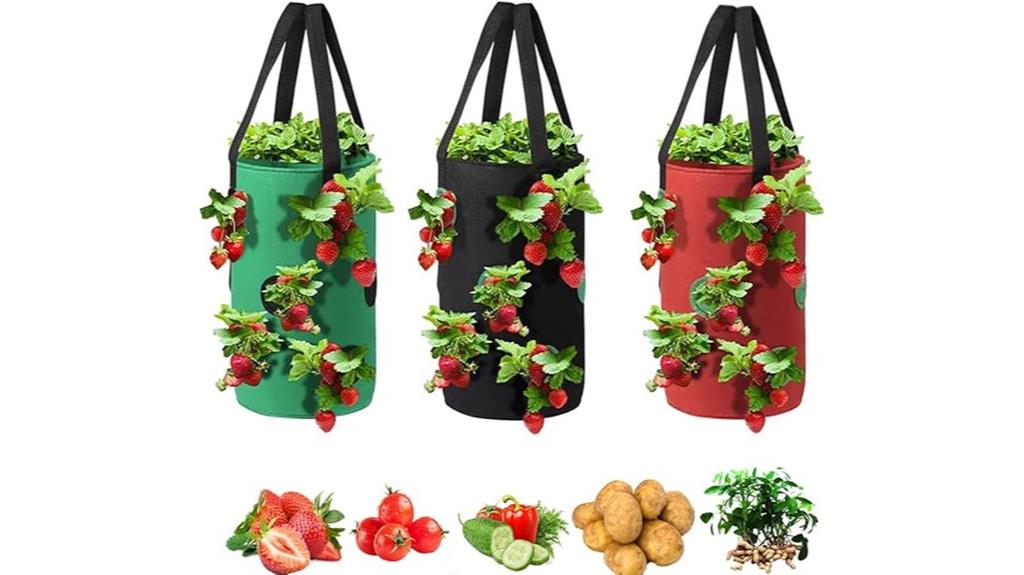
The Upside Down Tomato Planter, a 3-gallon hanging strawberry planter set, offers a fantastic solution for anyone with limited gardening space. Made from durable felt cloth, these planters come in red, green, and black, making them visually appealing. I love the breathable design that promotes air circulation, preventing root rot. With 12 planting holes, I can grow strawberries or even tomatoes without taking up much floor space. Users have reported successful growth, especially with bare-root plants. Just remember to pre-moisten the soil and adjust watering according to your plants’ needs, especially in warmer weather. Happy planting!
Best For: Gardeners with limited space looking to grow strawberries, tomatoes, or other plants in a compact and efficient manner.
Pros:
- Durable and breathable felt cloth material enhances plant growth by preventing root rot.
- Space-saving hanging design allows for gardening in small areas like balconies and terraces.
- Versatile with 12 planting holes, accommodating various plants while promoting good air circulation.
Cons:
- Some users find the planting holes too small for larger plants, risking root damage.
- Lack of clear instructions on planting techniques and soil mixtures can lead to confusion.
- May require additional watering techniques, such as drip irrigation, for optimal results.
10 Pack Strawberry Plant Support Racks
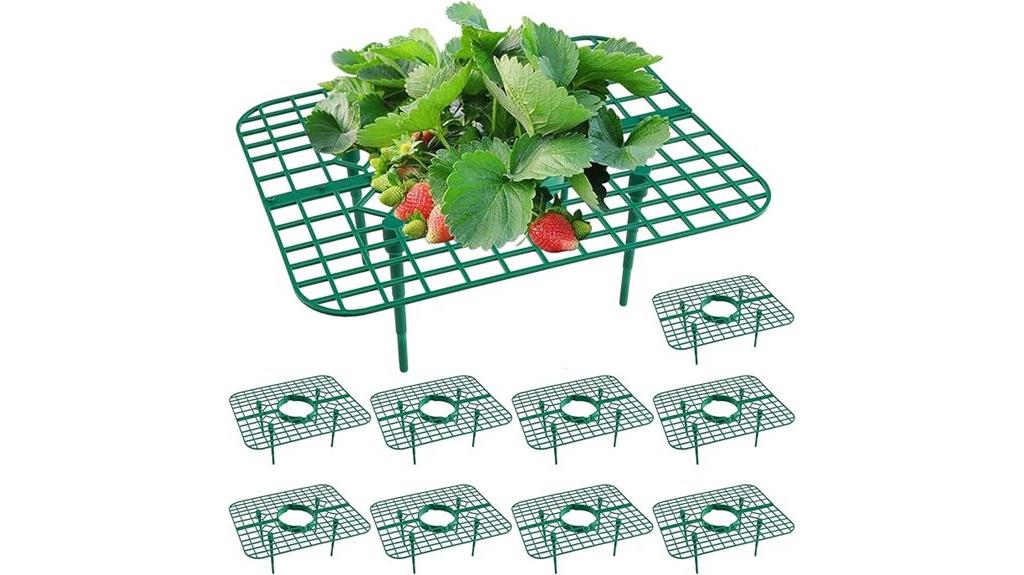
For gardeners enthusiastic to elevate their strawberry-growing game, the 10 Pack Strawberry Plant Support Racks by GOONMILL stands out with its practical design and easy installation. These racks measure 9.8 x 7.9 x 3.7 inches and weigh just 1.1 pounds, making them lightweight yet sturdy. I love how they keep my strawberries off the ground, promoting air circulation and healthy growth. Installing them is a breeze—just press and snap into the soil! Plus, they’re reusable and versatile enough for other fruits. Though some reviews mention durability issues, I find their support invaluable for a flourishing strawberry garden.
Best For: Gardeners who want to improve the growth and health of their strawberries and other fruits by keeping them elevated off the ground.
Pros:
- Easy to install with a simple press and snap mechanism.
- Promotes healthy growth by enhancing air circulation and keeping fruit off the ground.
- Reusable and versatile for various fruits and indoor or outdoor planting.
Cons:
- Some users have reported concerns about the durability of the plastic material.
- Aesthetics may not be as appealing compared to other support options on the market.
- Sturdiness may vary, with some users finding it less robust than desired.
VIVOSUN 5 Tier Vertical Gardening Stackable Planter

Looking to maximize your gardening space? The VIVOSUN 5 Tier Vertical Gardening Stackable Planter is perfect for growing strawberries and other short-root plants. Made from durable, fade-resistant materials, this sturdy planter can be stacked to fit any corner of your kitchen, balcony, or small garden. With a built-in water filtration system, it retains moisture while preventing ground stains. Just be mindful of stability when fully stacked and consider adding a central dowel for support. Most users rave about its aesthetic appeal and ease of assembly, making it an excellent choice for urban gardeners like me. Happy planting!
Best For: Urban gardeners with limited space looking to grow short-root plants like strawberries, herbs, and leafy greens.
Pros:
- Durable, fade-resistant materials ensure longevity and reuse.
- Space-efficient vertical design allows for cultivation in small areas like balconies and kitchens.
- Easy assembly and attractive aesthetic appeal enhance any gardening space.
Cons:
- Stability concerns when fully stacked may require additional support.
- Uneven light distribution for lower tiers can affect plant growth.
- Some users reported issues with water flow between tiers, needing modifications for optimal watering.
Buzzy Seeds Kids Mini Basin Seed Grow Kit, Strawberry
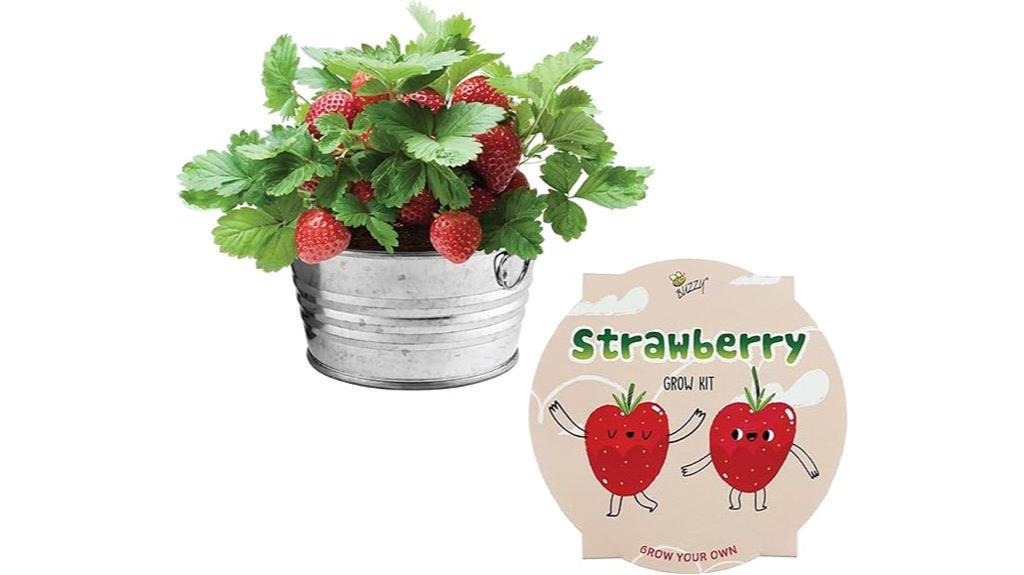
If you’re seeking a fun and educational way to introduce kids to gardening, the Buzzy Seeds Kids Mini Basin Seed Grow Kit for strawberries is an excellent choice. This compact kit includes a mini galvanized basin, seed packet, and growing medium, all designed for beginners. The easy-to-follow instructions make it simple for kids to understand the process of growing their own strawberries. With a 100% natural seed guarantee, you can feel confident in the kit’s quality. Plus, it’s a unique gift for parties or special events. Just remember to water it regularly, and watch those little plants thrive!
Best For: Families looking to engage children in gardening and teach them about plant growth through a hands-on experience.
Pros:
- Compact size makes it suitable for various indoor and outdoor spaces.
- Includes easy instructions that cater to beginners, making it accessible for kids.
- 100% natural seed guarantee ensures quality and promotes successful growth.
Cons:
- Mixed reviews on seed growth, with some customers experiencing disappointment.
- Limited to one type of plant, which may not appeal to everyone.
- Average rating of 3.2 stars suggests that not all users are satisfied with their experience.
20 Pack Square Strawberry Supports Plant Stand Holder
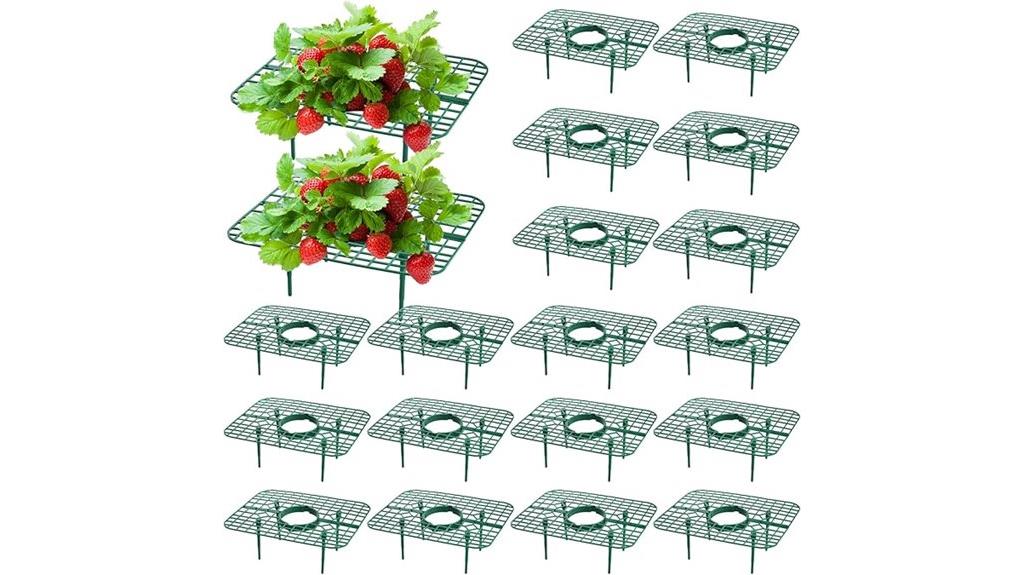
The Pack Square Strawberry Supports Plant Stand Holder is perfect for anyone enthusiastic to enhance their strawberry-growing experience. This 20-pack features high-quality PP plastic, ensuring durability and resistance to corrosion. Each support measures 9.7 x 7.9 x 3.8 inches once assembled, raising your strawberries off the soil to keep them clean and promote air circulation. I love how easy they are to set up—just clip the trays together, lock the buttons, and insert the legs into the ground. Plus, they’re versatile enough for potted plants and melons, making my gardening experience even more enjoyable!
Best For: Gardeners looking to optimize strawberry growth and improve fruit cleanliness.
Pros:
- Durable and corrosion-resistant due to high-quality PP plastic material.
- Easy assembly with a simple clip and lock design, saving time and effort.
- Versatile use for various plants, including potted plants and melons, enhancing gardening flexibility.
Cons:
- Limited to specific plant types, primarily strawberries and similar fruits.
- May require occasional re-stabilization in windy conditions.
- Size may not be suitable for larger fruit varieties or extensive plant growth.
FoxFarm Strawberry Fields Potting Soil (1.5 cu ft)
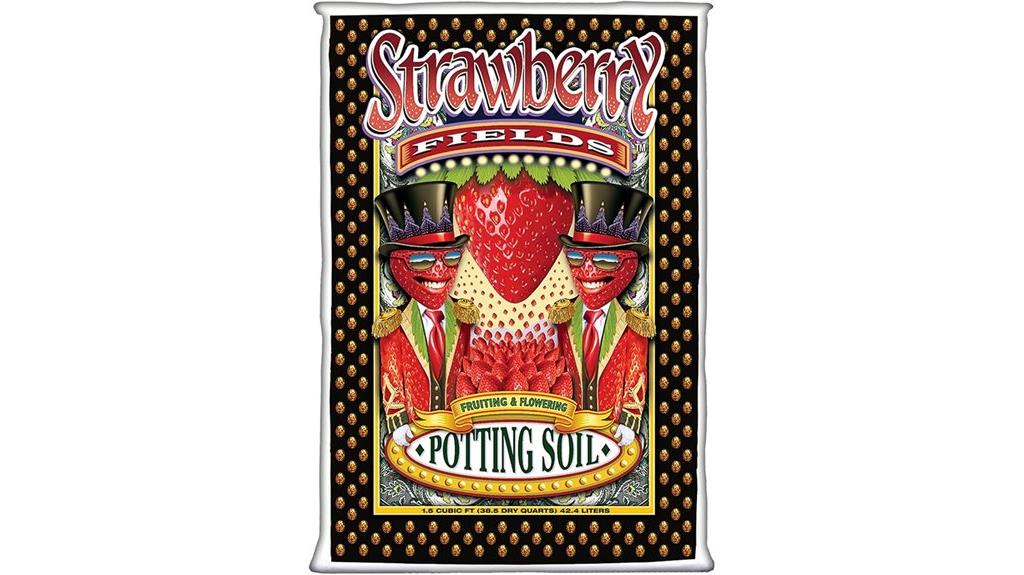
For anyone aiming to cultivate thriving strawberries, FoxFarm Strawberry Fields Potting Soil stands out as an excellent choice. This 1.5 cu ft potting mix is rich in phosphorus, which encourages robust fruiting and flowering. I love how it contains coco fiber, enhancing water retention to keep my plants hydrated. Users rave about the soil’s loamy texture, free of mud and insects, making it ideal for strawberries and other flowering plants. Just keep in mind that it has zero nitrogen, so you may need to add some nutrients if you’re growing seedlings. Overall, it’s a fantastic addition to any gardener’s toolkit!
Best For: Gardeners looking to enhance the fruiting and flowering stages of their herbaceous plants, particularly strawberries and tomatoes.
Pros:
- Rich in phosphorus, promoting healthy blooms and fruit development.
- Contains coco fiber for improved water retention and a loamy texture.
- Positive customer feedback highlights plant health improvements and overall quality.
Cons:
- Zero nitrogen content may require additional nutrient amendments for seedlings.
- Some users experienced fungus gnats, despite strong plant performance.
- Availability and pricing may vary, with some finding it cheaper locally.
Iceyyyy 10 Pack Strawberry Plant Support Racks
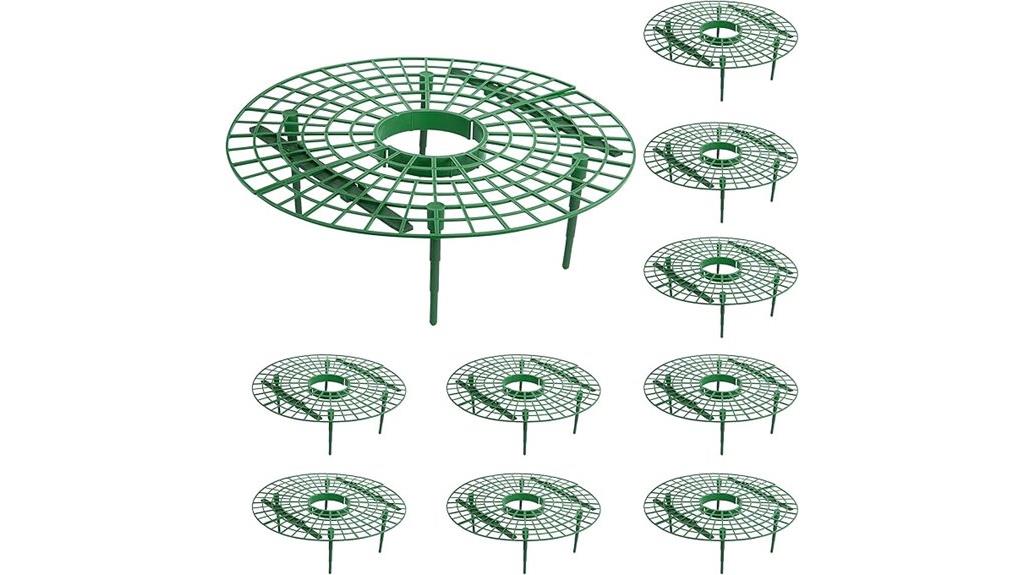
Looking to keep your strawberries pristine and off the ground? The Iceyyyy 10 Pack Strawberry Plant Support Racks are just what you need! Each pack includes two rails, four stakes, and a connecting rod, making assembly a breeze. I usually fit them around my plants before they grow large, but they’re effective even later on. Made from durable plastic, these supports help keep your berries clean and reduce pest issues. They’re lightweight, easy to move, and perfect for off-season storage. Plus, user reviews praise their effectiveness, with many noting how they deter slugs and snails. Give them a try!
Best For: Gardeners looking to keep their strawberries clean and elevate them off the ground to prevent pest issues.
Pros:
- Easy to assemble and adjust as plants grow.
- Made of durable plastic for long-lasting use.
- Helps prevent soil contact, reducing pest problems.
Cons:
- Some users find the supports can be flimsy.
- A few customers reported difficulty with peg fit during assembly.
- May not deter larger animals like squirrels or birds.
3 Tier Stackable Vertical Planter Set
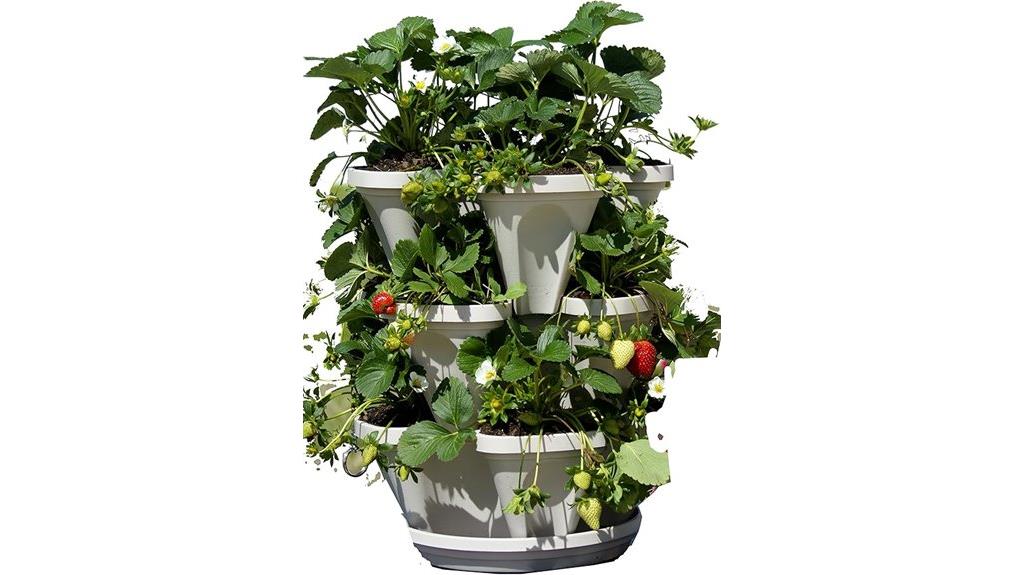
If you’re short on space but want to immerse yourself in strawberry gardening, the 3 Tier Stackable Vertical Planter Set is perfect for you. This innovative design allows you to grow up to 12 plants while saving valuable space, making it ideal for patios or even kitchen counters. The self-watering system efficiently distributes moisture from the top tier down, promoting healthy growth. Plus, it’s easy to assemble and comes with a bottom drip tray to catch excess water. With its modern gray finish, it not only serves a purpose but also enhances your gardening aesthetic. You’ll love the compliments it attracts!
Best For: Gardening enthusiasts with limited space who want to grow herbs, strawberries, and other plants indoors or outdoors.
Pros:
- Space-efficient design allows for vertical gardening, perfect for small areas like patios or kitchen counters.
- Self-watering system promotes healthy growth by distributing moisture evenly from the top tier down.
- Attractive modern design enhances the aesthetic appeal of indoor and outdoor spaces, often receiving compliments.
Cons:
- Sunlight requirement necessitates placement in well-lit areas, with possible need for daily rotation for even exposure.
- Water distribution may not be effective for all plants, leading to the need for individual watering in some cases.
- Minor assembly issues reported, with occasional defects upon arrival, although functionality remains intact.
Iceyyyy 10 Pack Strawberry Plant Support Stand

The Iceyyyy 10 Pack Strawberry Plant Support Stand is a game-changer for anyone wanting to grow strawberries efficiently. This set includes 2 rails, 4 stakes, and a connecting rod, making it easy to assemble around your plants. I found it particularly effective for keeping my strawberries off the ground, which helps prevent moisture exposure and keeps the berries clean. While the sturdy design is great, some users have mentioned issues with leg stability. Still, I appreciate that they’re removable for off-season storage. Overall, they’re functional and add a nice touch to my garden!
Best For: Gardeners looking to efficiently support their strawberry plants while preventing moisture exposure and keeping the berries clean.
Pros:
- Easy assembly with a straightforward design that fits around existing plants.
- Removable for off-season storage, eliminating the need for annual replacements.
- Promotes healthier growth by keeping plants organized and off the ground.
Cons:
- Some users report issues with leg stability and breakage.
- The legs may be perceived as flimsy, leading to concerns about sturdiness.
- Mixed reviews indicate that not all users find them effective for their specific needs.
Factors to Consider When Choosing Strawberry Growing
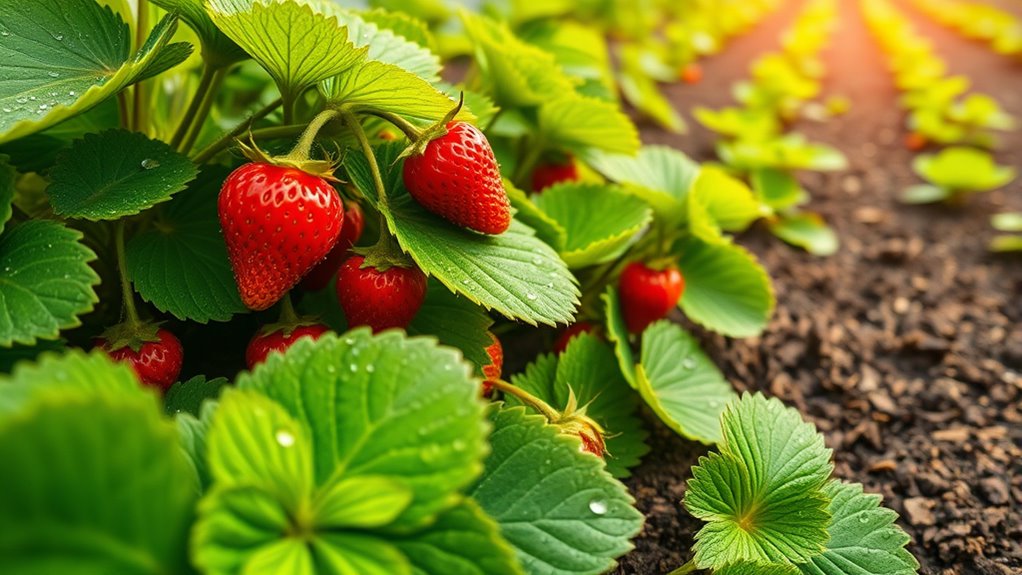
When I choose to grow strawberries, I always consider several key factors that can impact my success. The right plant variety, suitable growing environment, and soil quality are essential for thriving plants. Plus, I can’t forget about proper watering techniques and support structures to help them grow strong.
Plant Variety Selection
Choosing the right strawberry variety can make all the difference in your gardening success. First, I consider climate adaptability; for instance, Cavendish thrives in hardiness zones 2-10, making it a versatile option. If I’m short on space, I look for high-yielding varieties to maximize production, especially in container gardening. I also prefer varieties that are easy to grow and maintain, ensuring fruitful results even if I’m a novice. Additionally, strawberries that can flourish in multiple settings, like containers or hanging baskets, offer flexibility and efficiency. Finally, I pay attention to the growth cycle and fruiting time of different varieties to align with my gardening goals and seasonal availability.
Growing Environment Requirements
Creating the perfect environment for growing strawberries is vital for a bountiful harvest. I’ve found that these plants thrive in well-drained, fertile soil with a pH between 5.5 and 6.8. Full sunlight is a must, so I guarantee they get at least 6-8 hours of direct light each day. If you live in a colder zone, like I do, protecting them from frost is critical. I also pay attention to air circulation; spacing the plants properly helps prevent diseases. Finally, I make it a point to water them regularly, especially during dry spells, since strawberries prefer consistent moisture without being waterlogged. Following these guidelines has markedly improved my strawberry yield.
Soil Quality and Type
After establishing a suitable growing environment, the next step is to focus on soil quality and type. I’ve found that the ideal soil for strawberries is well-draining, rich in organic matter, and has a pH between 5.5 and 6.8. This balance promotes optimal growth and fruit production. When using potting mixes, I like ones that include coco fiber, sphagnum peat moss, and perlite, as they enhance aeration and moisture retention. To boost flowering and fruiting, I incorporate fertilizers high in phosphorus. Soil amendments like aged compost or earthworm castings can improve soil structure and nutrient content, which is essential for healthy root systems. Regularly testing the soil helps me adjust practices for better yields.
Watering Techniques and Frequency
When it comes to watering strawberries, consistency is key. I’ve found that watering deeply once a week encourages strong root growth, which is vital for healthy plants. Using drip irrigation or soaker hoses minimizes water on the leaves, helping to prevent fungal diseases. During hot, dry spells, I check the soil daily to make sure it doesn’t dry out, adjusting the frequency as needed. Strawberries thrive in well-drained soil, so I avoid overwatering to prevent root rot; letting the soil dry slightly between waterings is important. Additionally, I mulch around my strawberry plants to retain moisture, reduce watering frequency, and keep weeds at bay. This balanced approach makes a significant difference in my strawberry harvest!
Support Structures for Growth
Maintaining proper moisture levels for strawberries is just one part of ensuring their health and productivity. I’ve found that using support structures is essential for elevating the plants off the ground, which helps prevent diseases linked to soil contact. With supports in place, air circulates better around the strawberries, promoting healthier growth and reducing pest infestations. There are various designs, like stakes, racks, and modular systems, allowing flexibility for different growth stages. I love how properly installed supports lead to cleaner fruit, minimizing rot from splashing soil during watering or rain. Plus, many of these systems are easy to assemble and can be adjusted as the plants grow, giving ongoing support throughout the growing season.
Sunlight Exposure and Placement
Choosing the right spot for your strawberry plants is essential, as they thrive on full sunlight for at least 6-8 hours a day. I always avoid shaded areas, since reduced light can lead to poor growth and fewer berries. If space is tight, consider vertical planters or hanging systems to guarantee your plants get adequate sunlight. Rotating your strawberry plants can also help, especially if you’re using stacked or multi-tiered setups. This way, each plant receives even sunlight exposure. I recommend monitoring light conditions throughout the day, particularly in urban areas where buildings may cast shadows. By paying attention to these factors, you’ll set your strawberries up for healthy growth and maximum yields. Happy gardening!
Frequently Asked Questions
How Long Does It Take for Strawberries to Bear Fruit?
I’ve found that strawberries usually take about four to six weeks to bear fruit after flowering. When I first planted my strawberries, I was so excited to see those blooms! It felt like forever waiting for the juicy berries to appear. Patience is key, but trust me, the wait is worth it. Once you start harvesting, you’ll enjoy fresh strawberries that taste so much better than store-bought ones!
Can Strawberries Grow in Shaded Areas of the Garden?
Imagine a sun-drenched garden bursting with vibrant strawberries, but what if your patch is cloaked in shade? I’ve learned that while strawberries prefer sunlight, they can still grow in partially shaded areas. They might not produce as many fruits, but they’ll still thrive with some care. I’ve had success planting them under taller plants, where they catch dappled sunlight. Just make sure they get at least a few hours of indirect light each day!
What Are the Common Pests That Affect Strawberry Plants?
When I grow strawberries, I often encounter a few pesky pests. Aphids are common and can distort the leaves, while spider mites thrive in dry conditions, creating webbing. I’ve also dealt with slugs and snails, which love to munch on the fruit. To keep my plants healthy, I regularly inspect them and use natural deterrents. Managing these pests is essential for a bountiful strawberry harvest in my garden!
How Often Should I Water My Strawberry Plants?
I’ve found that watering strawberry plants is essential for their health. I usually water them deeply once a week, but during hot, dry spells, I increase it to two or three times weekly. It’s important to check the soil; if it feels dry an inch below the surface, it’s time to water. I aim to keep the soil consistently moist but not soggy, so my plants thrive and produce delicious berries.
When Is the Best Time to Harvest Strawberries?
I’ve found that the best time to harvest strawberries is when they’re fully ripe, which usually means they’ve turned a deep red color. I like to check them every few days during the peak season. If they’re still a bit green or have any white spots, I wait a little longer. Harvesting in the morning when it’s cooler helps keep them fresh, and I always pick them gently to avoid bruising.
Conclusion
In my experience, growing strawberries can be incredibly rewarding, especially when you have the right tools and techniques. Choosing the right plants, supports, and planters makes all the difference. I’ve found that when you pay attention to factors like sunlight, soil quality, and plant spacing, your strawberry yield can markedly improve. So, whether you’re a seasoned gardener or just starting out, remember that a little care and the right equipment can lead to a bountiful strawberry harvest!
